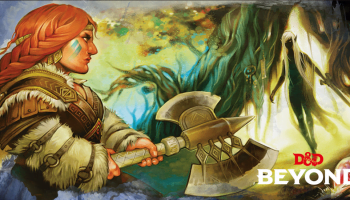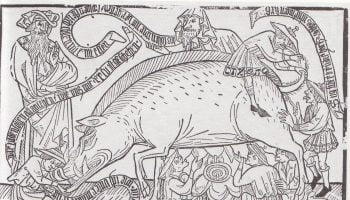Part XXXV in our ongoing series on Race, Racism and the Middle Ages, by Shiloh Carroll. You can find the rest of the special series here.
Shiloh’s upcoming book, Medievalism in A Song of Ice and Fire and Game of Thrones, is available for preorder now.
The idea of the Middle Ages as a uniform white culture is probably one of the most entrenched misconceptions about the medieval period. This is especially true when it comes to fantasy literature.
Western medievalist fantasy literature relies heavily on European history and mythological traditions. When people of color do appear in classic fantasy texts, they are very often portrayed as an “Other.” They are The Enemy, or at least a group against which the reader is expected to compare the dominant, white culture.

Helen Young, scholar of fantasy interpretations of the Middle Ages and author of Race and Popular Fantasy Literature, offers several examples of this in our most popular fantasy literature. She has pointed out that fantasy is built on a foundation of racist stereotyping in J.R.R. Tolkien’s The Lord of the Rings and Robert E. Howard’s Conan the Barbarian. While neither of these are technically medievalist, being intended more as prehistoric fantastic histories than medieval fantasies, they have still had a profound influence on the way medievalist fantasy approaches race. For example, in The Lord of the Rings, you need look no further than to Tolkien’s treatment of Orcs, Uruk-hai, and Haradrim, all of whom are evil, and the only ones described as having dark skin. There was also a very clear geographical division between his “white” elves, humans, dwarves, and hobbits and the dark, evil lands of Orcs (Mordor) and Haradrim (Harad) in the south.

C.S. Lewis’ Chronicles of Narnia also does this. Lewis’ Calormenes, a pseduo-Middle Eastern culture, are the villains in The Horse and His Boy and The Last Battle.
These authors may not have intended for their work to be racist. If they were alive, they might be horrified at these allegations. But whether these authors intended for their work to be racist doesn’t really matter. The works of these authors began a tradition that has profoundly (though, one hopes, not irrevocably) shaped how race is treated in fantasy up to the present day. This has kept our fantasy literature’s treatment of race rooted in thinking from the 1930s, 40s, and 50s.
Tolkien’s portrayal of the “pseudo-medieval” world of Middle Earth strongly influenced subsequent fantasy literature. By proxy, this has had a significant impact on the broader public understanding of the Middle Ages. This is the beginning of what Young, in her studies of fantasy fandoms, has described as a “feedback loop.” In this feedback loop, readers are exposed to a medievalist version of the Middle Ages through fantasy. They then come to believe that this medievalist version is an “accurate” portrayal of the Middle Ages. Having done that, people then insist on this version of the Middle Ages in future literature because it is “accurate.” Round and round it goes. Eventually, all fantasy versions of the Middle Ages look more-or-less the same.
And few fantasy books are more a product of this self-reinforcing process than George R.R. Martin’s A Song of Ice and Fire series.
A Song of White People and Fire
George R.R. Martin’s epic fantasy series A Song of Ice and Fire has been, more than nearly any other fantasy work in modern history, examined for its basis in real medieval history. Martin himself claimed that his novels are more-solidly based in history than any other fantasy work, even Tolkien. He told John Hodgeman in an interview:
I sort of had a problem with a lot of the fantasy I was reading, because it seemed to me that the middle ages or some version of the quasi middle ages was the preferred setting of a vast majority of the fantasy novels that I was reading by Tolkien imitators and other fantasists, yet they were getting it all wrong.
In a 1996 Publishers Weekly interview, Martin also said:
Tolkien had a great influence on me, but the other influence on A Song of Ice and Fire was historical fiction, which I don’t think is really true for a lot of the other fantasies that are coming out. Their historical background, the texture of their worlds, tends to be rather thin.
He frequently decries the “Tolkien-imitators” with their “Ren Faire Middle Ages,” because they include tendencies he sees as inaccurate: “peasants sassing princesses,” black-and-white morality, indestructible heroes, and an unwavering belief in, and adherence to, a code of chivalry.
Historical authenticity is the well he returns to time and again to explain issues in his construction of Westerosi culture. When fans have expressed disappointment that there aren’t more people of color in the books (or that those people of color—such as the Dornish—are cast as far whiter than they hoped in the show), he tries to explain it away. His explanation: in medieval England, France, and Scotland “there was the occasional person of color, but certainly not in any great numbers,” due to the difficulty of travel.
But Martin isn’t a very good medieval historian. While he has a clear fascination with history, his approach focuses on “juicy stuff”—big historical movements like the Hundred Years War and the Wars of the Roses—while avoiding “academic tomes about changing patterns of land use.” He readily admits, in interviews, to changing or “heightening” history to make it more interesting and fantastical. In other interviews, especially when challenged on the violence, rape, sexual assault, child marriage, and other disturbing elements in the novels, he falls back on their supposed historical authenticity.
He has a tendency to generalize, taking the culture of a specific place or time in the Middle Ages and using it as a marker for the entirety of the era. When he talks about history, he rarely gets more specific than “the Middle Ages” (he never says, for example, “the Tudor era”), and makes broad, general claims about the period, such as “It was very classist, dividing people into three classes. And they had strong ideas about the roles of women.” Therefore, while his arguments that travel and immigration were rare in the Middle Ages may be true of some places and times, it is not true (as this series has repeatedly shown) of all of the Middle Ages, either temporally or geographically.
Of course, Martin isn’t writing history, or even historical fiction. He isn’t required to be historically accurate. Fantasy is, by its nature, transformative and speculative. It allows us to create better worlds, to explore the lives of others, to strip away the banalities of everyday life and dive deep into our hopes, fears, dreams, psyches, pasts, and futures. Martin himself waxed poetic about the power of fantasy in Patti Parret’s The Faces of Fantasy, saying:
We read fantasy to find the colors again, I think. To taste strong spices and hear the song the sirens sang. There is something old and true in fantasy that speaks to something deep within us, to the child who dreamt that one day he would hunt the forests of the night, and feast beneath the hollow hills, and find a love to last forever somewhere south of Oz and north of Shangri-La.
In writing A Song of Ice and Fire, Martin did not choose to be bound to the Wars of the Roses; he chose to write a medievalist fantasy world. And his world doesn’t include a lot of mixing of races. That is the problem.
This has been disappointing for his fans, many of whom are people of color who would like to see themselves reflected in his world. And moreover, these fantasy fans of color would love to see more good characters of color in works as major and influential as A Song of Ice and Fire. But not including them is Martin’s prerogative.
The problem truly arises when his fans believe (with his encouragement) that his neomedieval world is authentically medieval and use that belief to shape their idea of history rather than the other way around.
The problem is the feedback loop. Martin argues that a primarily white Middle Ages is historically accurate. This leads some of his readers to believe that Westeros is an accurate depiction of the Middle Ages (because Martin says it is). Thus, anything Martin writes is an accurate depiction of the Middle Ages. This is, of course, all based on what the reader “feels” the Middle Ages was like, and much of this “feeling” comes from reading medievalist fantasy. Of course, many readers push back against this, arguing for a more nuanced view of the Middle Ages, or (as I have here) that medievalist fantasy is not historical fiction. But reading critically and against the text can be very difficult, and often the loudest voices in the room are from those who refuse to interrogate their preconceived notions.
Game of White People

In this way, of course, Martin’s issues with race are quite different from Tolkien’s. Tolkien, as I mentioned in the beginning of this article, runs into trouble with his simple white skin/black skin, good/evil dichotomy. Martin’s work suffers from somewhat-subtler issues, namely a lack of representation, and when he does choose to include people of color, he also includes some pretty ugly stereotypes about them.
These stereotypes are most evident in Daenerys Targaryen’s storyline. Her story begins with her wedding to a Dothraki horse lord—which, without “at least three deaths,” she is told, “would be a dull affair.” She winds up becoming a “white savior” for the enslaved peoples of Slavers Bay. Martin reacted to one question about the stereotypical portrayal of the Dothraki by arguing that he doesn’t have any Dothraki point-of-view characters, indicating that the Dothraki might look very different from the inside. But he also doesn’t express any intention of adding a Dothraki point-of-view character, or, presumably, a Meereenese one or Astapori one.
Not until A Feast for Crows, the fourth book in the series, do we get any person of color at all as a point-of-view character (Arianne Martell), though she is still technically Westerosi, being from Dorne. In fact, only one point-of-view character (Melisandre) is from outside Westeros, and not only does she have only one chapter so far, she’s white.
When it comes to portraying Martin’s fantasy world in the HBO TV series, the problems get even worse. When John Boyega (star of, among other things, the latest Star Wars films) mentioned how overwhelmingly white the cast of Game of Thrones is (along with The Lord of the Rings, and Star Wars), the comments section on fan site Winter is Coming descended into hostile, often nakedly racist, remarks.
They argued that the Middle Ages wasn’t diverse. They argued that attempting to “force” diversity is “politically correct nonsense” that panders to “snowflakes.” And they even accused Boyega of being a racist for bringing up this problem at all. In their minds, even discussing racial inequality is racist. By their warped logic, the only way not to be racist is to pretend race does not exist.
A similar issue occurred at another Game of Thrones fan-community website: Watchers on the Wall. When Lupita Nyong’o mentioned—in passing—that she’d like to cameo on Game of Thrones, one of the contributors wrote a thoughtful piece discussing the issues of representation in the show. These attitudes raised the question of how much of a viewer’s expectation for a white Westeros comes from a preconceived notion of a “white Middle Ages,” and how much is resistance to so-called “political correctness”—namely when people of color ask for a seat at the table. The comments section, while not as horrid as the Winter is Coming one, again leaned heavily on the “historical accuracy,” artistic freedom, and “not everything needs to be about race” arguments to dismiss said contributor’s concerns.
Racist Fantasies vs. Inclusive Histories
Westeros, of course, is a fantasy world. Like Tolkien’s Middle Earth, you can argue that it does not owe anything to any real, historical period on Earth. But it is the continuous insistence, on the part of Martin and many fans, that Westeros is a relatively accurate representation of the Middle Ages that makes this discussion necessary. You can’t have it both ways.
Many people get their ideas of what the Middle Ages were like from fantasy works like A Song of Ice and Fire. As such, it is important for medievalists to point out that the kind of historical accuracy that Martin strives for is ultimately impossible; works like Game of Thrones are, fundamentally, fantasies. This is especially true now, with the renewed attempt by white supremacists to co-opt the Middle Ages. The myth of a “whites-only Middle Ages” that is perpetuated through the fantasy genre in general (and through massively popular shows like Game of Thrones in particular), is indeed a myth. The past is much more complicated, and inclusive, than many give it credit for.
If you enjoyed that article, please share it with your history-loving friends on Facebook, or on Twitter! And be sure to subscribe here to receive every new article from The Public Medievalist the moment it launches.





Martin is also handwaving away the fact that apart from several people attempting to gain a throne, his work resembles the War of the Roses about as much as a cabbage resembles a filet mignon.
Seriously, there is almost nothing about the series that one could point to as being any reflection of that period of English history: not the reasons for the conflict, the motives of the characters, the relationships between individuals or nations – nothing, other than conflict over wh sits in the chair at any given point.
(This is Shiloh)
I have no problem with him claiming the Wars of the Roses and the Hundred Years War as inspiration. We all get inspiration from somewhere and start with something. It’s the whole “this is an accurate reflection of the historical Middle Ages and therefore better fantasy than everyone else’s” claim/attitude that I really take issue with.